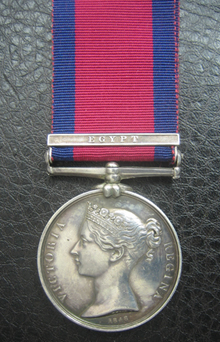
MILITARY GENERAL SERVICE 1793, CLASP EGYPT ‘J. LITTLE, 8TH FOOT’.
James Little, a labourer from Armagh, Ireland, enlisted into the 8th Foot on 25 May 1798. With his Regiment, he took part in the Egyptian campaign of 1801 and was one of 49 men from the 8th to receive the Military General Service Medal with the Egypt clasp.
During the 1812 War against America, Private Little was serving with 4 Company, which was one of the companies stationed at Fort George in Upper Canada when the Americans attacked on 27th May 1813. The battle, which was an American victory, was a particularly severe one for the 8th foot, during which they suffered the brunt of the casualties, or approximately 50% of the near 500 Officers and men from the Regiment present. Private Little was one of the casualties, his service papers noting he was:
‘wounded in the left thigh and left arm in action at Fort George Upper Canada 27 May 1813’.
Little is also listed as one of those men taken prisoner. However his service papers note he joined the 4th Royal Veteran Battalion on 25 December 1813, so it is likely he was paroled by the American’s within days, as many of those that were severely were.
Little was discharged from the Army at Quebec on 24 September 1816 in the disbandment of his Battalion. His final discharge on being returned to the UK being at Chatham on 4 March 1817. He was 41 years old and had 18 years and 123 days service in the Army.
On May 25, American batteries along the Niagara river and at Fort Niagara opened fire on Fort George damaging or destroying almost all the buildings within its walls. Only the casemates within the Fort’s walls themselves offered protection for the garrison’s soldiers, women and children. This bombardment signalled to the British commander, Brigadier General John Vincent that an invasion was imminent. Vincent had 1300 men at his disposal, approximatly1000 Regulars from 8th and 49th Foot, Newfoundland Fencibles, Glengary Light Infantry, the balance men from Canadian Militia and Indian’s.
On May 26, Dearborn began to embark his troops, numbering 5000. The plan decided upon was that the light troops would first land on the lakeshore led by Winfield Scott and Benjamin Forsyth, and secure the beach head for the rest of the brigades to land. The early next morning on May 27, the American fleet with the invasion force under cover of a heavy fog. With no breeze in the air it was slow moving for the flotilla. The fog soon lifted to reveal that the Americans were on the move. While the element of surprise had been removed, Vincent still did not know were the Army would land. With only 1300 troops available and unable to cover all possible landing spots, Vincent chose to withdrew troops from the lakeshore and concentrated them on the river. He chose wrong.
Once the landing boats left the American flotilla and it became obvious that the lakeshore was their destination, Vincent scrambled to re-direct troops back to Lake Ontario. The light troops, two companies of the Glengarry Light Infantry Fencibles and one of the Royal Newfoundland Fencibles and militia were dispatched from his force to meet the American landing. Rushing into action, the Canadians charged the disembarking Americans under Scott with the bayonet. While climbing out of his boat, Scott himself was forced to dodge a bayonet from a Glengarry, but falling into the cool waters of Lake Ontario. As wave after wave of thousands of US regulars landed the Canadian troops were slowly beaten back and retired to a position held by the 8th Regiment. Further attempts were made, this time by the 49th Regiment and militia, to halt the American advance but without success.
Outnumbered and in the process of being outflanked, Vincent decided to make a hasty evacuation of Fort George. So fast was the pullout and under constant bombardment from Fort Niagara, that the women and children of the 49th and other corps were left behind in the casements of the fort. To avoid the American army moving from the shores of Lake Ontario towards Fort George, Vincent retreated up the Niagara river to Queenston then cut north with detachments from Fort Erie and Queenston towards Burlington Heights, leaving the Niagara peninsula under US control. While Washington was pleased with this success, the hope of the invasion was to destroy completely Vincent’s small army leaving Upper Canada west of Kingston at the mouth of the St. Lawrence in the hands of the US. The US army then could deal with British on the Detroit river at their leisure. But this was not the case.
Casualties at Fort George were; Americans 41 killed and 113 wounded. British 52 killed, 44 wounded, 262 missing/prisoner (approx 50% of these wounded). 246 of the casualties were from the 8th Foot. Of the 92 NCO’s/Men present in Private Little’s 4 Company, casualties were particularly heavy with 10 killed and 33 taken prisoner. Only 5 Company suffering more with 6 killed and 45 taken prisoner.
Condition GVF, attractive patina with just minor contact marks. A fine and scarce 1812 War casualty medal. Ex GLEN. NOV 1903 & FEB 1963.